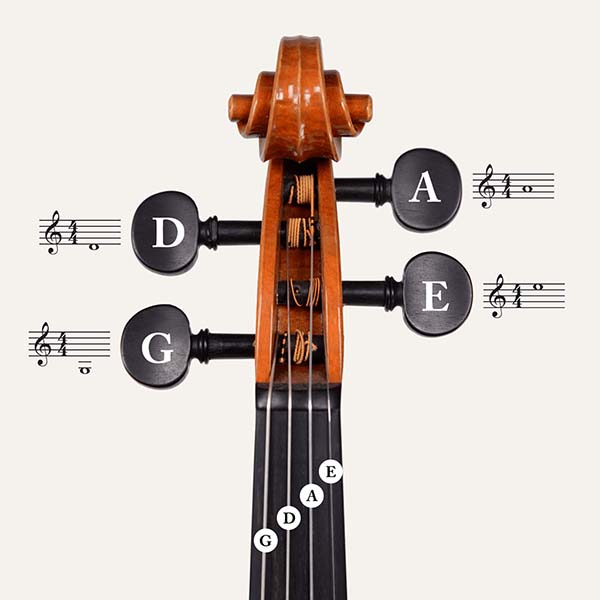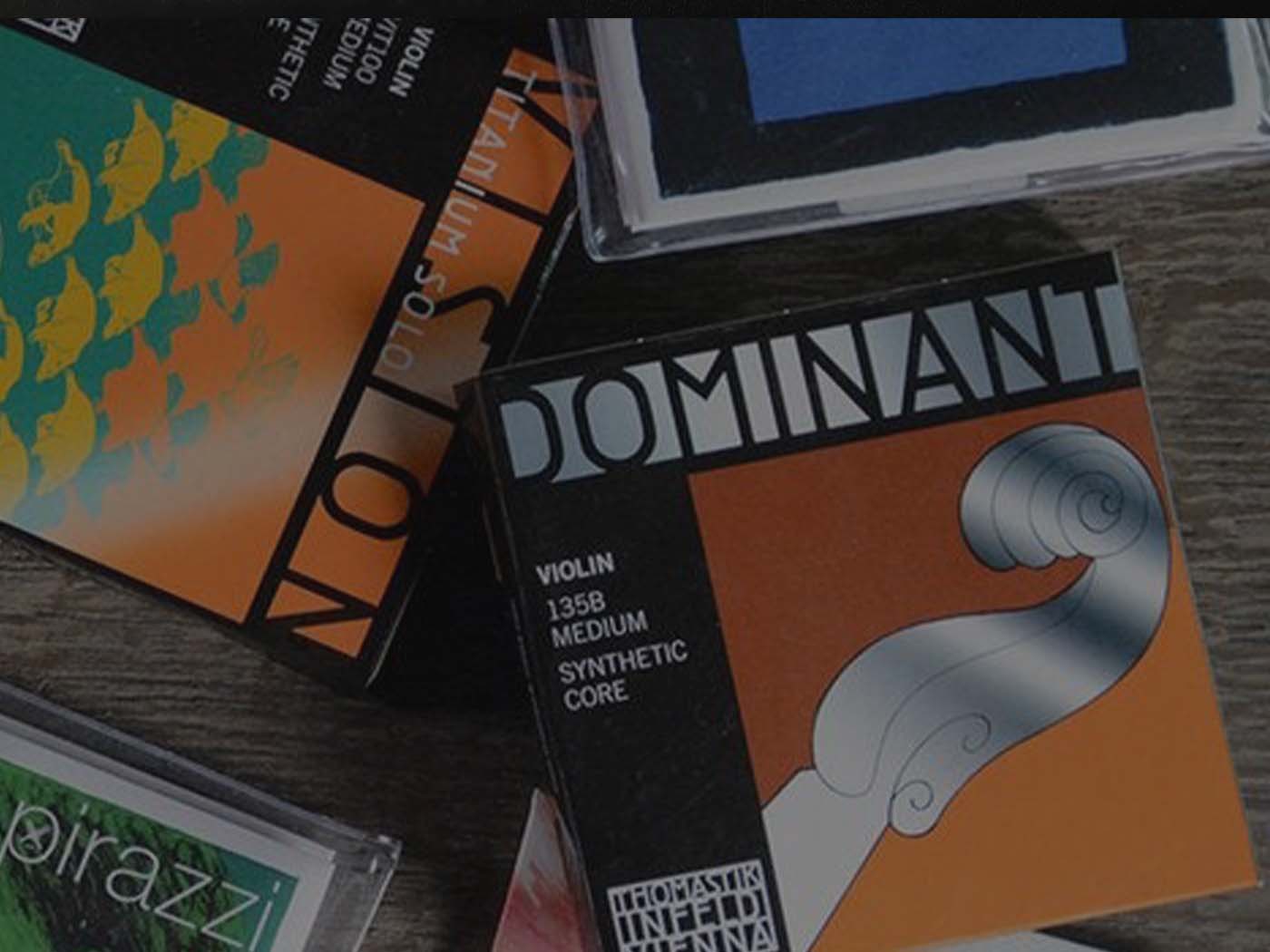Violin strings are an essential supply for violinists, and when shopping for strings you will find an abundance of options - different materials, tensions, sizes, and sounds. But how do you know which set is right for you? If you are new to the violin or just looking to try a different brand, it can be helpful to have some basic knowledge about strings. You can also check out our interactive Violin String Comparison Chart to learn more about the differences between many of the top brands.
Modern string brands have a lot in common: they are constructed of an inner core and an outer winding, wrapped with fabric at the peg end and finished with a ball or loop at the tailpiece end. The different materials and methods used in string making will influence their sound and playing characteristics.
Lifespan
The life expectancy of strings can vary - the more you use them the faster they wear out. You can generally expect around 4 to 12 months of use from them. If you play more than a few hours a day, strings can lose their vibrance after just a few months. It helps to keep them clean by wiping away rosin and perspiration after playing.
For synthetic strings, a good indication that your strings have gone "false" is that they are harder to tune, and playing in tune seems more challenging than it used to. They will also sound less lively, and start to lack the full, "ringing" sound they once had. If the winding on your string is coming apart, its sound will be limited or fuzzy, and it will likely break.
Your Instrument
Every instrument has its own unique sound and character, and you may want to experiment with different strings to find the best match for your instrument. Before trying every string out there, it is a good idea to make sure your instrument is in proper working order. Switching string brands or tensions might not help an instrument with a bad bridge or poorly placed sound post. Ideally, take your violin to a luthier to have them check that everything is in the right place. Violins have many small parts that must line up just right, or strange things can happen and your sound can be limited.
Check out some of our Care & Maintenance Videos if you want to learn more about what you can do to keep your instrument in good condition.
The Core
Steel core strings have an inner core made from solid steel or strands of steel. Generally, steel strings have a quick response and sound strong and brilliant. But they can also sound metallic, and often lack depth or character. They can help brighten the dull-sounding instrument, as well as fractional size instruments. They are used widely in styles such as country, folk, or jazz - you will also find them in school orchestras. It can be difficult to play perfectly in tune with these strings because of their non-flexible nature, and when applying pressure with the bow the pitch sharpens a bit. Steel strings are usually the least expensive option.
Synthetic core strings tend to be the most popular; often the best all around choice for a strong, clear sound with an abundance of overtones and excellent playability. In most cases they produce more volume than steel strings while remaining stable in pitch. The synthetic core is made of a kind of polymer (nylon, perlon, etc.) that is formed into strands. It seems that each manufacturer does something a little different, maybe even top secret!
Gut core strings are the original type of string - used for centuries on all kinds of string instruments. They are usually made from sheep intestines. Gut strings are lower in tension and tend to have the warmest sound, with a wide range of interesting tonal colors. You can use gut core strings to help bright and brilliant sounding instruments, or when tuning down (i.e. early music.) These strings are a bit temperamental depending on your climate - they can be difficult to keep in tune, and need to be played with sensitivity. Here in South Florida, players rarely use them as they behave poorly in the high heat and humidity.
E-Strings
A common question about E-strings is whether you need a ball or loop end. You will need to look at your fine tuner to decide which one you need. Usually the ball will be held by two hooks, and the loop will have one hook.

Modern E-strings are made of steel, and you may notice that this string has the most options of all. The plain steel E is essentially a steel wire - it has a direct and warm tone without being too shrill. Other variations are plated with metals like tin, chrome, gold, platinum, or titanium. Each metal has a unique sound and feel, and they can sometimes last longer than a plain steel string.
Another option is the "wound" E-string, made with an inner core and outer winding like the other strings. These are slightly thicker and have a somewhat slower response. Wound E-strings have a warmer tone, and can help fix a squeaky E situation.
Tension & Winding
String tension and gauge are two different terms that refer to the same thing when talking about strings. Tension is how much force is held between the two ends, and gauge is the thickness of the string. Thicker strings usually have higher tension. Additionally, stronger metals can be used to change the string tension without changing the thickness.
Higher tension strings require more force to be activated, and may be harder to press with the left hand. Conversely, lower tension strings require less force, and feel more pliable under the fingers. Steel strings are usually higher tension, while gut are lower.
Altering the tension can also change the sound. For example, if one or two of your strings sound too bright or weak, you can try a thicker string. If one or two of your strings sound too dark or non-responsive and slow, you can try a thinner string. However, unless it is recommended to you by a luthier or professional, medium tension is probably what you should use. Switching to a higher or lower tension can have unpredictable results depending on the instrument.
The winding on the outside of the string is made from flat metal that is evenly wrapped around the core. Different metals can be used to alter the sound, tension, and feel of the string. Furthermore, some players may find that their perspiration reacts poorly with specific metals, causing the winding to become tarnished quickly. If the winding of your string is damaged, the sound and response of the string will be greatly reduced, and it will likely break.
Aluminum and silver are common metals used for the winding, but other options include chrome steel, nickel, gold, and even hydronalium. Each material will have a subtle effect on the sound and feel of the string, and the manufacturer usually mentions this in product details.
If you have any questions about strings, or if you're looking for recommendations, feel free to reach out to us!








2 comments
Fiddlershop
Hi Paul!
So sorry about the late reply…
The strings should last about 6 months if you play almost every day.
We are so happy that you enjoy your Concert violin! Thanks for letting us know 😃
Hi Paul!
So sorry about the late reply…
The strings should last about 6 months if you play almost every day.
We are so happy that you enjoy your Concert violin! Thanks for letting us know 😃
Paul Lanier
I just wanted to ask how long my fiddlerman strings should last on my Fiddlerman Concert. Right now As a beginner I’m practicing 2-3 hours 5-6 days a week. I received my violin on July 6, 2021. Thank you, I’m really enjoying my violin.
I just wanted to ask how long my fiddlerman strings should last on my Fiddlerman Concert. Right now As a beginner I’m practicing 2-3 hours 5-6 days a week. I received my violin on July 6, 2021. Thank you, I’m really enjoying my violin.